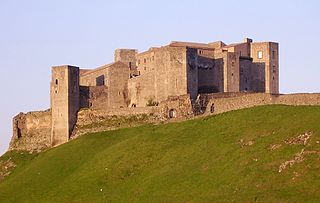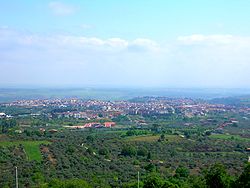
Benevento is a city and comune (municipality) of Campania, Italy, capital of the province of Benevento, 50 kilometres (31 mi) northeast of Naples. It is situated on a hill 130 metres above sea level at the confluence of the Calore Irpino and the Sabato. In 2020, Benevento has 58,418 inhabitants. It is also the seat of a Catholic archbishop.

Basilicata, also known by its ancient name Lucania, is an administrative region in Southern Italy, bordering on Campania to the west, Apulia to the north and east, and Calabria to the south. It has two coastlines: a 30-km stretch on the Tyrrhenian Sea between Campania and Calabria, and a longer coastline along the Gulf of Taranto between Calabria and Apulia. The region can be thought of as the "arch" of the "boot" of Italy, with Calabria functioning as the "toe" and Apulia the "heel".

Robert Guiscard, also referred to as Robert de Hauteville, was a Norman adventurer remembered for his conquest of southern Italy and Sicily in the 11th century.

Conversano is an ancient town and comune in the Metropolitan City of Bari, Apulia, south-eastern Italy. It is 30 kilometres (19 mi) southeast of Bari and 7 kilometres (4 mi) from the Adriatic coast, at 219 metres (719 ft) above sea level.

Lucania was a historical region of Southern Italy, corresponding to the modern-day region of Basilicata. It was the land of the Lucani, an Oscan people. It extended from the Tyrrhenian Sea to the Gulf of Taranto. It bordered with Samnium and Campania in the north, Apulia in the east, and Bruttium in the south-west, and was at the tip of the peninsula which is now called Calabria. It comprised almost all the modern region of Basilicata, the southern part of the Province of Salerno, the western part of Province of Taranto and a northern portion of the Province of Cosenza.

Lecce is a city in southern Italy and former capital of the province of Lecce, with the second-highest population in the Apulia region. It is on the Salentine Peninsula, at the heel of the Italian Peninsula, and is over two thousand years old.

Grumentum was an ancient Roman city in the centre of Lucania, in what is now the comune of Grumento Nova, c. 50 km (31 mi) south of Potenza by the direct road through Anxia, and 80 km (50 mi) by the Via Herculia, at the point of divergence of a road eastward to Heraclea.

Altamura is a town and comune of Apulia, in southern Italy. It is located on one of the hills of the Murge plateau in the Metropolitan City of Bari, 45 kilometres southwest of Bari, close to the border with Basilicata. As of 2017, its population amounts to 70,595 inhabitants.

Andria is a city and comune (municipality) in the Apulia region of Southern Italy. It is an agricultural and service center, producing wine, olives and almonds. It is the fourth-largest municipality in the Apulia region and the largest municipality of the province of Barletta-Andria-Trani. It is known for the 13th-century Castel del Monte.

Eboli is a town and comune of Campania, southern Italy, in the province of Salerno.

Potenza is a comune in the Southern Italian region of Basilicata.

Montescaglioso is a town and comune in the Province of Matera, Basilicata, southern Italy.

Grottole is a town and comune in the province of Matera, in the region of Basilicata in southern Italy.

Acquaviva delle Fonti is a town and comune of 20,446 inhabitants, in the Metropolitan City of Bari, in Apulia, Italy. Acquaviva is famous for its characteristic red onions, which have been awarded the DOP mark. The main monuments are the Palazzo de Mari, the Co-Cathedral of Sant'Eustachio and the ancient village. The town is located on the Murge plateau at an elevation of 300 metres (980 ft) above sea level, and is 26 kilometres (16 mi) from the Adriatic Sea and Bari, which is the biggest city of the region. The Ionian Sea is more than 45 kilometres (28 mi) to the south.

The history of the Jews in Calabria reaches back over two millennia. Calabria is at the very south of the Italian peninsula, to which it is connected by the Monte Pollino massif, while on the east, south and west it is surrounded by the Ionian and Tyrrhenian seas. Jews have had a presence in Calabria for at least 1600 years and possibly as much as 2300 years. Calabrian Jews have had notable influence on many areas of Jewish life and culture. The Jews of Calabria are virtually identical to the neighbouring Jews of Sicily but are considered separate. However, the Jews of Calabria and the Jews of Apulia are historically the same community, only today are considered separate. Occasionally, there is confusion with the southern Jewish community in Calabria and the northern Jewish community in Reggio Emilia. Both communities have always been entirely separate.

Nola is a town and a municipality in the Metropolitan City of Naples, Campania, southern Italy. It lies on the plain between Mount Vesuvius and the Apennines. It is traditionally credited as the diocese that introduced bells to Christian worship.

The Castle of Melfi in Basilicata is a monument owned by the Italian State and one of the most important medieval castles in Southern Italy. Its construction, at least the components still visible, dates back to the Norman conquest and has undergone significant changes over time, especially under the House of Anjou and the Crown of Aragon.
The History of the Jews in Campania and Basilicata is at least 2000 years old. This area, which is a mix of mountains and rich fertile plains, is south of Rome but north of Calabria and Apulia. Most of the Jewish communities were settled in the Roman Era by Jewish merchants or by Jewish captives after the fall of Jerusalem in the year 70. However, the region was mostly abandoned by the Jews by middle of the 16th century. Today, only the city of Naples has a Jewish population. And, unlike the southern provinces, there seems to be no interest by neofiti descendants to revive the Jewish faith.

The Abbey of Santissima Trinità or Abbey of the Most Holy Trinity, Italian: Abbazia della Santissima Trinità, is a Roman Catholic abbey complex at Venosa, in the Vulture area of the province of Potenza, in the southern Italian region of Basilicata. The architecture of the abbey shows Roman, Lombard, and Norman influences. The complex lies within the Parco Archeologico of Venosa, approximately 1.5 km north-east of the town; it falls under the Roman Catholic Diocese of Melfi-Rapolla-Venosa. It consists of the old church, of uncertain date; the monastery buildings; and the Incompiuta, the unfinished or new church, begun in the last quarter of the eleventh century and never completed. The complex was declared a National Monument by Royal Decree on 20 November 1897. It is no longer a monastery, but is used by the Trinitarian Order.
Pirro Del Balzo was a southern Italian nobleman, a protagonist of resistance against the House of Trastámara kings of Naples and Sicily.

























